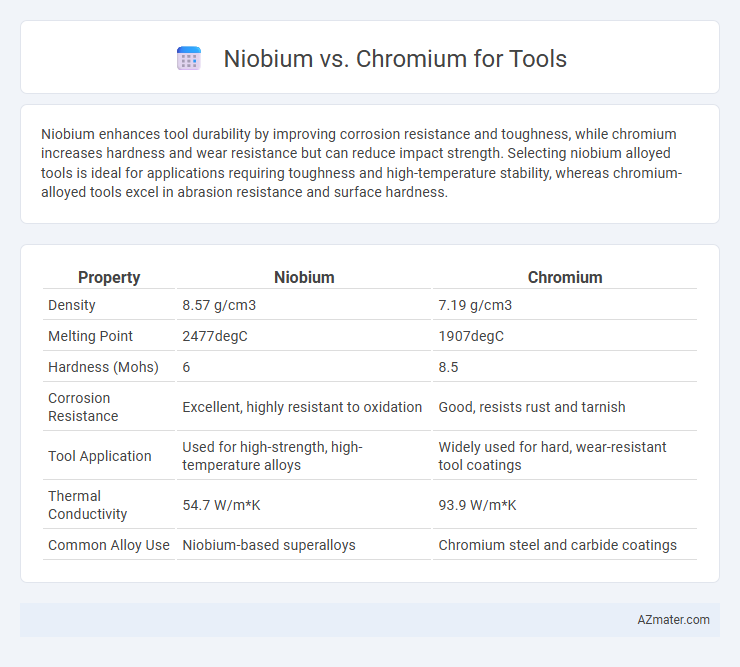Niobium enhances tool durability by improving corrosion resistance and toughness, while chromium increases hardness and wear resistance but can reduce impact strength. Selecting niobium alloyed tools is ideal for applications requiring toughness and high-temperature stability, whereas chromium-alloyed tools excel in abrasion resistance and surface hardness.
Table of Comparison
| Property | Niobium | Chromium |
|---|---|---|
| Density | 8.57 g/cm3 | 7.19 g/cm3 |
| Melting Point | 2477degC | 1907degC |
| Hardness (Mohs) | 6 | 8.5 |
| Corrosion Resistance | Excellent, highly resistant to oxidation | Good, resists rust and tarnish |
| Tool Application | Used for high-strength, high-temperature alloys | Widely used for hard, wear-resistant tool coatings |
| Thermal Conductivity | 54.7 W/m*K | 93.9 W/m*K |
| Common Alloy Use | Niobium-based superalloys | Chromium steel and carbide coatings |
Introduction to Niobium and Chromium in Tool Manufacturing
Niobium and chromium are critical elements in tool manufacturing due to their unique metallurgical properties. Niobium enhances toughness, wear resistance, and corrosion resistance by stabilizing carbides and refining grain structure in steel alloys. Chromium is primarily valued for increasing hardness, tensile strength, and oxidation resistance, making it essential in stainless tool steels and coatings.
Chemical Properties Comparison: Niobium vs Chromium
Niobium exhibits excellent corrosion resistance and forms stable oxides, enhancing tool durability in aggressive environments compared to chromium. Chromium offers superior hardness and corrosion resistance by forming a passive oxide layer, critical for wear-resistant tool surfaces. Both elements improve alloy strength, but niobium's higher melting point and lower density influence thermal stability and tool weight differently than chromium.
Mechanical Strength and Durability Analysis
Niobium enhances mechanical strength and durability in tool steels by refining grain size and improving toughness, making it highly effective in resisting wear and impact. Chromium contributes to hardness and corrosion resistance, but tools alloyed with niobium show superior toughness and fatigue resistance under high-stress conditions. Combining niobium with chromium can optimize tool performance by balancing hardness, strength, and durability for demanding industrial applications.
Resistance to Corrosion and Wear
Niobium alloys exhibit superior corrosion resistance compared to chromium, making them ideal for tools exposed to harsh chemical environments. While chromium enhances hardness and wear resistance in steel alloys, niobium's ability to form stable carbides significantly improves wear resistance without compromising toughness. Tools incorporating niobium demonstrate longer service life and reduced maintenance costs due to enhanced resistance to both wear and corrosive damage.
Impact on Tool Hardness and Toughness
Niobium enhances tool hardness by forming stable carbides that improve wear resistance, while also increasing toughness through refined grain structures. Chromium contributes to tool hardness by creating a hard, corrosion-resistant surface layer, yet may reduce toughness if present in excessive amounts. Combining niobium with chromium alloys optimizes the balance between hardness and toughness, crucial for high-performance tool applications.
Cost Efficiency and Material Availability
Niobium offers superior cost efficiency for tool manufacturing due to its excellent strength-to-weight ratio and enhanced corrosion resistance, which extends tool life and reduces replacement frequency. Chromium is more abundant and widely available, making it a cost-effective choice for applications where high hardness and wear resistance are required but longevity is less critical. The choice between niobium and chromium depends on balancing initial material cost with long-term performance benefits in tool durability and maintenance.
Machinability and Fabrication Challenges
Niobium offers superior machinability compared to chromium due to its lower hardness and better thermal conductivity, allowing for smoother cutting and reduced tool wear during fabrication. Chromium, while providing excellent hardness and corrosion resistance, presents fabrication challenges such as increased brittleness and difficulty in cutting, often requiring specialized tooling and slower machining speeds. Selecting niobium for tooling applications can enhance production efficiency by minimizing machining time and lowering the risk of tool failure, especially in complex fabrication processes.
Applications in Industrial Tools
Niobium enhances industrial tools by improving toughness, wear resistance, and high-temperature strength, making it ideal for cutting and drilling equipment exposed to extreme conditions. Chromium contributes to corrosion resistance and hardness, crucial for cutting tools, molds, and dies used in harsh environments. Combining niobium and chromium alloys optimizes tool durability and performance in heavy-duty manufacturing and metalworking applications.
Environmental and Safety Considerations
Niobium offers superior corrosion resistance and lower toxicity compared to chromium, making it a safer option for tool manufacturing with reduced environmental impact during production and disposal. Chromium, especially hexavalent chromium, is known for its carcinogenic properties and poses significant environmental hazards through toxic waste emissions and contamination risks. Choosing niobium-enhanced tools minimizes harmful exposure and aligns with stricter environmental regulations and sustainability goals.
Future Trends in Tool Material Innovations
Niobium is gaining traction in tool material innovations due to its superior high-temperature strength and corrosion resistance, which extend tool life and performance in extreme environments. Chromium remains essential for enhancing hardness and wear resistance, but future trends show hybrid alloys incorporating niobium to achieve balanced toughness and durability. Advanced manufacturing techniques like additive manufacturing enable precise niobium-chromium composite tools, driving the next wave of cutting-edge, high-performance tooling solutions.

Infographic: Niobium vs Chromium for Tool
 azmater.com
azmater.com